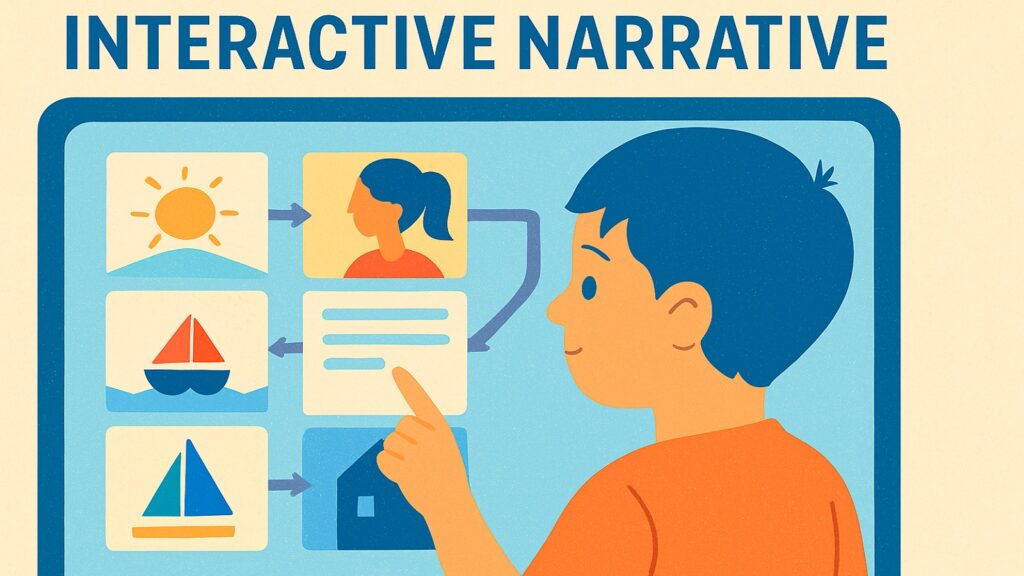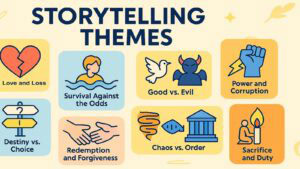Table of Contents
Introduction: How Interactive Narratives Are Changing the Way We Think
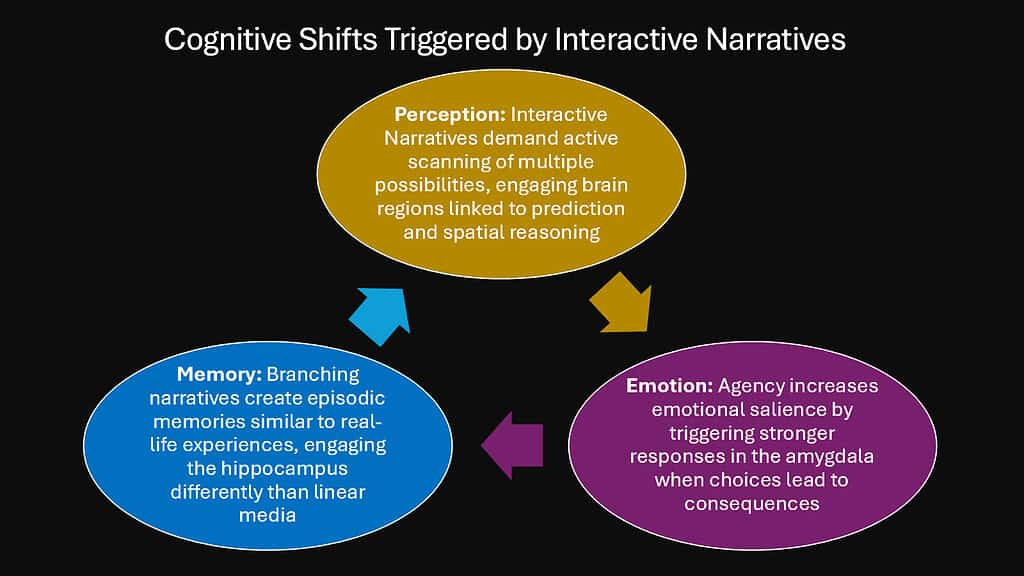
Something profound is happening to the human mind. While our ancestors gathered around fires to hear stories told in linear progression, we now find ourselves wielding unprecedented power over narrative itself. Interactive narratives have emerged as one of the most important storytelling formats of our digital age, fundamentally altering how we process information, make decisions, and understand cause and effect.
Unlike traditional storytelling methods that guide audiences through predetermined paths, interactive narratives invite participation in ways that reshape cognitive architecture. Where oral storytelling relies on collective listening and shared cultural memory, interactive narratives demand individual choice-making that creates unique mental pathways. Digital storytelling may incorporate multimedia elements, but interactive narratives go further by making the audience co-creators of meaning. Poetry and dramatic scripts offer emotional resonance through language and performance, while graphic narratives combine visual and textual elements. Yet none of these formats fundamentally alter the relationship between story and recipient the way interactive narratives do.
The significance extends beyond entertainment into neuroscience territory. Research suggests that when we actively participate in narrative construction, our brains engage different neural networks than those activated by passive consumption. Memory formation becomes dynamic rather than static. Emotional investment deepens through personal agency. Time perception shifts as we navigate branching possibilities rather than following singular timelines.
This cognitive transformation manifests across six key areas that reveal how interactive narratives are rewiring human consciousness. They restructure how we understand choice and consequence, deepen emotional connections through participatory experience, alter temporal perception through nonlinear storytelling, create new frameworks for ethical decision-making, reshape memory formation into collaborative processes, and prepare minds for adaptive thinking required in an increasingly complex world.
| Storytelling Formats | Primary Engagement Mode | Audience Role | Memory Formation |
|---|---|---|---|
| Oral Storytelling | Auditory Reception | Passive Listener | Collective Cultural Memory |
| Digital Storytelling | Multimedia Consumption | Active Viewer | Enhanced Visual Recall |
| Poetry | Language Interpretation | Emotional Interpreter | Metaphorical Associations |
| Dramatic Scripts | Performance Observation | Audience Member | Character-Driven Memories |
| Graphic Narratives | Visual-Text Integration | Reader | Sequential Image Memory |
| Interactive Narratives | Choice-Based Participation | Co-Creator | Personalized Experience Memory |
1. Interactive Narratives and the Architecture of Choice
Interactive narratives fundamentally challenge the traditional relationship between story and audience by transforming readers from passive recipients into active architects of meaning. This shift creates new cognitive pathways that traditional linear narratives cannot access, establishing what researchers call “participatory consciousness” where meaning emerges through the interaction between the story system and the individual choices.
The transformation becomes evident when examining how interactive narratives dismantle conventional story structures. Traditional narratives follow established patterns of exposition, rising action, climax, and resolution. Interactive narratives explode these frameworks into networks of possibility where multiple climaxes, alternative expositions, and branching resolutions coexist simultaneously. Each choice point becomes a moment where the audience rewrites not just the story’s direction but their own relationship to narrative causality.
Structuralism provides crucial insight into this phenomenon. Roland Barthes described traditional narratives as systems of signs and codes that convey predetermined meanings. Interactive narratives destabilize this system by making signs fluid and codes participant-dependent. When a player chooses to save or sacrifice a character, they are not merely selecting from preset options but actively reorganizing the entire semiotic structure of the story. The same narrative signs—character relationships, symbolic objects, thematic elements—acquire different meanings based on audience intervention.
This restructuring has measurable cognitive effects. Studies of players engaging with choice-based narratives show increased activation in the prefrontal cortex, particularly areas associated with executive function and moral reasoning. The brain treats each choice point as a genuine decision rather than a fictional scenario, creating neural patterns similar to those activated during real-world problem-solving.
The implications extend beyond individual experience into collective meaning-making. Traditional stories create shared cultural references through common narrative experiences. Interactive narratives generate fragmented but personalized mythologies where each participant carries unique story-memories that resist simple cultural transmission. This fragmentation may be creating new forms of empathy, as people become more capable of understanding multiple perspectives simultaneously.
| Structuralist Element | Traditional Narrative | Interactive Narrative | Cognitive Impact |
|---|---|---|---|
| Signs | Fixed Meaning | Fluid Interpretation | Enhanced Symbol Processing |
| Codes | Universal Application | Participant-Dependent | Personalized Meaning Creation |
| Binary Oppositions | Clearly Defined | Contextually Negotiated | Complex Moral Reasoning |
| Narrative Functions | Linear Sequence | Network Structure | Systems Thinking Development |
| Reader Position | Outside Observer | Inside Participant | Agency-Based Learning |
2. Emotional Gravity: How Interactive Narratives Deepen Empathy and Connection
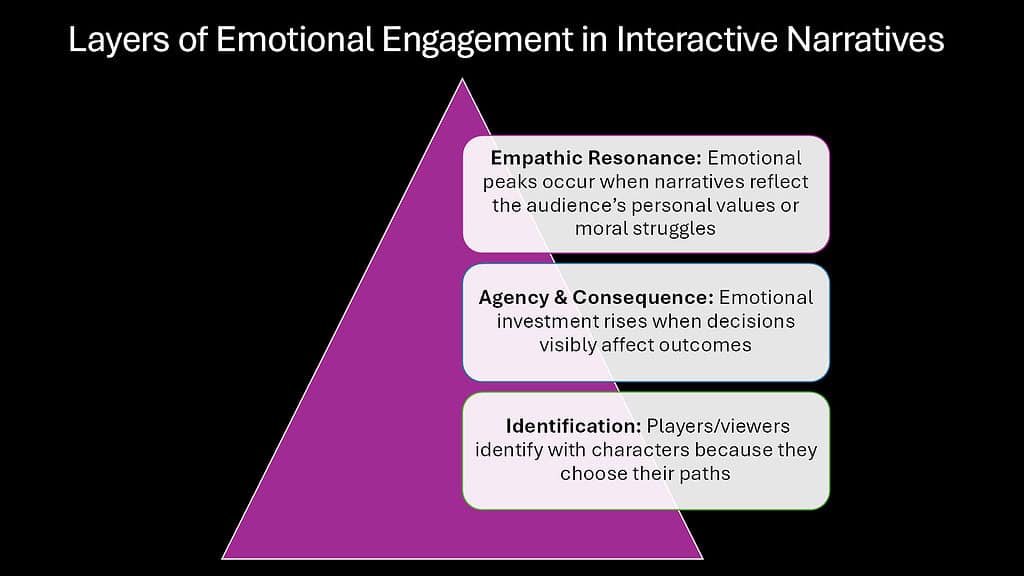
The emotional landscape of interactive narratives operates through mechanisms that traditional storytelling cannot replicate. When audiences make choices that directly influence character fates and story outcomes, their emotional investment transcends the typical relationship between reader and text. This phenomenon creates what cognitive scientists term “consequential empathy,” where emotional responses become amplified through personal agency and responsibility.
Traditional narratives generate empathy through identification and projection. Readers sympathize with characters facing challenges, but this sympathy remains fundamentally observational. Interactive narratives transform sympathy into something more complex and personally demanding. When a player must decide whether to lie to protect a friend or tell the truth that causes pain, their emotional engagement becomes visceral rather than intellectual. The weight of consequences creates emotional memories that persist long after the narrative experience ends.
Research into mirror neuron activation reveals significant differences between passive and interactive narrative engagement. Brain imaging studies show that interactive choice-making activates not only the mirror neuron systems responsible for empathy but also the anterior cingulate cortex and insula, brain regions associated with personal emotional processing and self-awareness. This suggests that interactive narratives create hybrid emotional experiences where the boundaries between fictional and personal emotional investment blur.
The depth of connection manifests in ways that surprise even experienced storytellers. Players report forming stronger emotional bonds with interactive narrative characters than with protagonists from traditional media. This phenomenon appears related to what psychologists call the “IKEA effect”—the tendency to value things more highly when we contribute to their creation. By participating in character development through choices, audiences become emotionally invested in ways that pure observation cannot achieve.
Cultural implications emerge as interactive narratives become more prevalent. Traditional stories often reinforced existing empathy patterns by presenting familiar moral frameworks. Interactive narratives force audiences to inhabit unfamiliar emotional territories where simple moral categories break down. This experience may be developing new forms of emotional intelligence better suited to complex contemporary moral landscapes.
| Empathy Type | Mechanism | Emotional Depth | Memory Formation | Long-term Impact |
|---|---|---|---|---|
| Observational Empathy | Character Identification | Surface Sympathy | Episodic Memory | Temporary Emotional Response |
| Consequential Empathy | Choice-Based Investment | Deep Emotional Engagement | Autobiographical Memory | Lasting Behavioral Change |
| Projected Empathy | Imaginative Placement | Moderate Connection | Semantic Memory | Cultural Understanding |
| Participatory Empathy | Co-Creative Experience | Integrated Emotional Learning | Procedural Memory | Enhanced Moral Reasoning |
3. Time in Flux: Interactive Narratives and the Reimagining of Story Flow
Interactive narratives revolutionize temporal experience by fragmenting linear time into networks of possibility that mirror how human consciousness actually processes experience. Unlike traditional stories that move audiences through predetermined temporal sequences, interactive narratives create what temporal theorists call “subjective chronologies” where time becomes a navigable dimension rather than an immutable flow.
The transformation of temporal perception becomes evident when examining how interactive narratives handle causality. Traditional narratives present cause and effect in clear sequences where actions lead predictably to consequences. Interactive narratives create multiple causal chains that exist simultaneously, allowing audiences to explore different temporal pathways through the same narrative space. This multiplicity fundamentally alters how the brain processes sequential information.
Narratology offers essential frameworks for understanding these temporal disruptions. Gerard Genette’s analysis of narrative time—distinguishing between story time, discourse time, and reading time—becomes complex when applied to interactive formats. Interactive narratives introduce a fourth temporal dimension: choice time, where the moment of decision exists outside normal narrative flow. Each choice point creates a temporal pause where multiple future timelines exist in potential, collapsing into actuality only through participant intervention.
Brain imaging studies reveal that navigating nonlinear narratives activates different neural networks than those engaged by linear storytelling. The hippocampus, crucial for spatial and temporal navigation, shows increased activity during interactive narrative engagement. This suggests that the brain processes interactive narratives more like physical environments than traditional texts, creating spatial-temporal maps rather than linear sequences.
The cognitive implications extend into everyday time perception. Regular engagement with interactive narratives appears to enhance mental flexibility around temporal concepts. Players develop improved abilities to hold multiple timeline possibilities in mind simultaneously, a skill increasingly valuable in complex decision-making contexts. This temporal flexibility may represent a crucial cognitive adaptation for navigating contemporary information environments where linear processing proves inadequate.
Memory formation also transforms under these conditions. Traditional narrative memories follow episodic patterns where events connect in temporal sequence. Interactive narrative memories become more complex, resembling what cognitive scientists call “scenario-based memories” where multiple potential outcomes remain accessible even after specific choices are made.
| Temporal Element | Linear Narrative | Interactive Narrative | Cognitive Processing | Neural Activation |
|---|---|---|---|---|
| Causality | Direct Sequence | Multiple Chains | Sequential Logic | Prefrontal Cortex |
| Time Flow | Unidirectional | Multidirectional | Temporal Mapping | Hippocampus |
| Story Duration | Fixed Length | Variable Experience | Attention Management | Anterior Cingulate |
| Memory Formation | Episodic Sequence | Scenario Networks | Pattern Recognition | Default Mode Network |
| Future Projection | Single Outcome | Multiple Possibilities | Predictive Processing | Medial Prefrontal Cortex |
4. The Ethics of Agency: When Interactive Narratives Test Our Moral Compass
Interactive narratives create unprecedented ethical landscapes where moral decision-making becomes participatory rather than observational. This transformation forces audiences to confront ethical dilemmas not as philosophical abstractions but as lived experiences with concrete consequences. The shift from moral observer to moral agent fundamentally alters how ethical reasoning develops and operates within narrative contexts.
Traditional storytelling presents moral frameworks through character actions and consequences that audiences witness but do not directly influence. Interactive narratives make moral agency unavoidable. Every significant choice carries ethical weight because participants bear responsibility for outcomes. This responsibility creates what ethicists term “experiential moral learning” where abstract ethical principles become embodied through consequence-bearing decisions.
The psychological impact proves profound. When participants make morally ambiguous choices in interactive narratives, they experience genuine moral stress similar to real-world ethical dilemmas. Brain imaging reveals activation in the same neural networks involved in actual moral decision-making, including the ventromedial prefrontal cortex and posterior superior temporal sulcus. This suggests that fictional moral choices engage authentic moral reasoning systems rather than hypothetical thinking processes.
Research into moral psychology shows that interactive narrative experiences can genuinely influence real-world ethical reasoning. Participants who navigate complex moral scenarios in interactive formats demonstrate enhanced moral imagination and improved ability to consider multiple ethical perspectives simultaneously. This enhancement appears to result from the embodied nature of interactive moral decision-making, where consequences feel personally meaningful rather than abstractly theoretical.
The implications for moral education are significant. Traditional ethical instruction relies heavily on case study analysis and theoretical framework application. Interactive narratives provide experiential learning environments where moral reasoning develops through practice rather than instruction. Participants learn to navigate moral complexity not by memorizing ethical rules but by experiencing the weight and uncertainty of moral choice.
Cultural considerations emerge as interactive narratives become global phenomena. Different cultural moral frameworks produce different choice patterns within the same interactive scenarios, creating opportunities for cross-cultural moral dialogue. This global moral conversation through shared interactive experiences may be developing new forms of ethical understanding that transcend traditional cultural boundaries.
| Moral Learning Mode | Engagement Type | Consequence Experience | Memory Formation | Behavioral Transfer |
|---|---|---|---|---|
| Theoretical Study | Intellectual Analysis | Abstract Understanding | Semantic Memory | Limited Application |
| Case Study Review | Observational Learning | Hypothetical Scenarios | Episodic Memory | Moderate Transfer |
| Interactive Experience | Embodied Decision-Making | Consequential Outcomes | Autobiographical Memory | Strong Behavioral Change |
| Experiential Learning | Personal Agency | Immediate Feedback | Procedural Memory | Integrated Moral Development |
5. Memory as a Living Story: How Interactive Narratives Reshape Recall
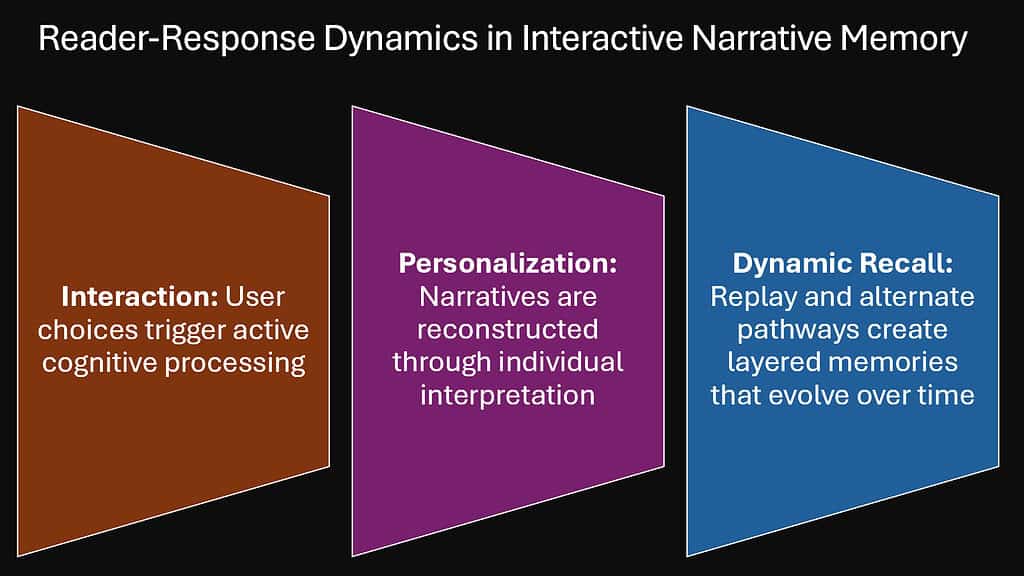
Interactive narratives fundamentally transform memory formation by creating dynamic, participatory experiences that evolve through repeated engagement. Unlike traditional stories that generate fixed memories of predetermined events, interactive narratives produce what memory researchers call “constructive memories” where each recall experience potentially alters the memory itself.
Reader-Response Theory provides crucial insights into this phenomenon. Wolfgang Iser argued that literary meaning emerges through the interaction between text and reader, creating “implied readers” who complete the text through interpretation. Interactive narratives extend this concept into memory formation itself. Each playthrough creates not just a different story experience but a different memory structure, making participants co-authors of their own recollections.
The neuroscience of interactive narrative memory reveals distinct patterns from traditional story recall. While linear narrative memories typically consolidate into stable episodic structures, interactive narrative memories remain more fluid and reconstructive. Neuroimaging studies indicate that the recollection of interactive narrative experiences engages both memory retrieval systems and creative construction networks, implying that the process of remembering these experiences entails active reconstruction instead of mere passive playback.
This reconstructive quality creates unique opportunities for memory enhancement and therapeutic application. Interactive narratives designed for memory training show promising results because they engage multiple memory systems simultaneously. Spatial memory develops through navigation of choice trees, procedural memory strengthens through repeated decision-making patterns, and autobiographical memory deepens through personal investment in outcomes.
The collaborative nature of interactive narrative memory extends beyond individual experience. Players often share and compare their different pathway choices, creating collective memory constructions that transcend individual experience. These shared memory reconstructions resemble oral tradition processes but operate through digital participation rather than cultural transmission.
Long-term implications for memory culture appear significant. As interactive narratives become more prevalent, memory itself may become increasingly collaborative and reconstructive. Traditional cultural memory relied on shared story versions that preserved collective identity. Interactive narrative memory creates fragmented but personally meaningful recall experiences that may be reshaping how cultural memory operates in digital environments.
| Memory Type | Formation Process | Stability Level | Recall Accuracy | Personal Relevance |
|---|---|---|---|---|
| Linear Narrative Memory | Passive Reception | High Stability | Consistent Recall | Moderate Relevance |
| Interactive Choice Memory | Active Construction | Dynamic Stability | Variable Recall | High Personal Investment |
| Collaborative Memory | Shared Construction | Fluid Stability | Negotiated Accuracy | Community Relevance |
| Reconstructive Memory | Co-Creative Process | Adaptive Stability | Evolving Accuracy | Deep Personal Meaning |
| Cultural Memory | Traditional Transmission | Fixed Stability | Standardized Recall | Collective Identity |
6. Future Minds: How Interactive Narratives Prepare Us for Adaptive Thinking
Interactive narratives are creating cognitive capabilities that align with the complex problem-solving demands of contemporary and future environments. By training minds to navigate multiple possibility spaces, manage uncertainty, and make decisions with incomplete information, these narrative experiences develop what cognitive scientists call “adaptive intelligence”—the ability to thrive in unpredictable and rapidly changing contexts.
The cognitive training effects become apparent when examining how interactive narrative engagement influences executive function. Players develop enhanced working memory capacity through managing multiple story variables simultaneously. Cognitive flexibility improves as participants learn to shift between different strategic approaches based on emerging story conditions. Inhibitory control strengthens through resisting immediate gratification in favor of long-term narrative goals.
Research into problem-solving transfer shows that interactive narrative skills generalize to non-narrative contexts. Participants demonstrate improved performance in complex decision-making scenarios, enhanced ability to consider multiple perspectives simultaneously, and greater comfort with ambiguous situations where optimal solutions are not immediately apparent. These improvements suggest that interactive narratives function as cognitive training environments for twenty-first-century thinking skills.
The implications for education and professional development are profound. Traditional educational approaches emphasize linear knowledge acquisition and predetermined problem-solving methods. Interactive narratives offer experiential learning environments where adaptive thinking develops through practice rather than instruction. Students learn to navigate complexity not by memorizing solutions but by developing flexible cognitive strategies that transfer across domains.
Workplace applications are emerging as organizations recognize the value of adaptive thinking skills. Interactive narrative training programs help employees develop better decision-making under uncertainty, improved collaboration across diverse perspectives, and enhanced creative problem-solving capabilities. These programs simulate complex workplace scenarios while maintaining the engagement and motivation that traditional training methods often lack.
The broader cultural implications suggest that interactive narratives may be preparing human consciousness for post-linear thinking patterns better suited to digital age challenges. As information environments become increasingly complex and interconnected, the ability to think in networks rather than sequences becomes crucial for effective functioning.
| Cognitive Skill | Traditional Development | Interactive Narrative Training | Transfer Potential | Future Relevance |
|---|---|---|---|---|
| Linear Problem-Solving | Step-by-Step Methods | Network Navigation | Moderate Transfer | Declining Relevance |
| Adaptive Reasoning | Case Study Analysis | Choice Consequence Learning | High Transfer | Increasing Importance |
| Systems Thinking | Theoretical Frameworks | Emergent Pattern Recognition | Strong Transfer | Critical Future Skill |
| Uncertainty Management | Risk Assessment Models | Experience-Based Learning | Excellent Transfer | Essential Capability |
| Perspective Integration | Diversity Training | Collaborative Story Building | Superior Transfer | Fundamental Requirement |
Conclusion: Why Interactive Narratives Are the Next Great Leap in Human Storytelling
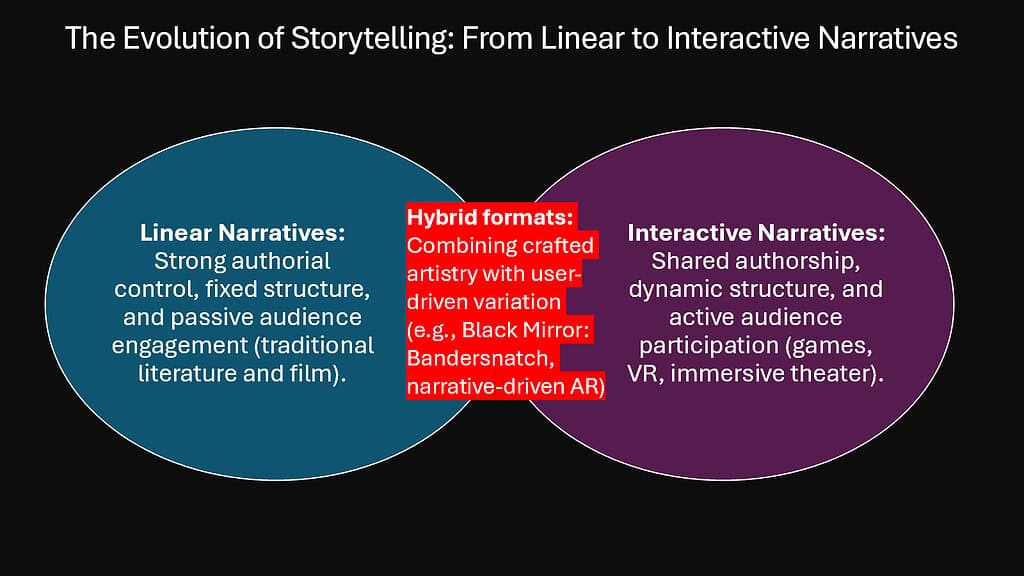
Interactive narratives represent more than technological innovation in entertainment—they constitute a fundamental evolution in human cognitive development. By transforming audiences from passive recipients into active participants, these narrative forms are rewiring neural networks, reshaping memory formation, and developing thinking skills essential for navigating contemporary complexity.
The evidence across six key domains reveals the profound impact of interactive narratives on human consciousness. They restructure choice architecture in ways that enhance executive function and moral reasoning. They deepen emotional connections through consequential empathy that transcends traditional identification patterns. They transform temporal perception by making time navigable rather than fixed, developing cognitive flexibility crucial for complex decision-making. They create experiential moral learning environments where ethical reasoning develops through embodied practice rather than theoretical instruction. They generate dynamic, reconstructive memories that become more personally meaningful through participatory creation. They train adaptive thinking skills that transfer effectively to non-narrative contexts requiring creative problem-solving.
These cognitive transformations correspond with the requirements of a world that is becoming more interconnected and is changing at a rapid pace. Linear thinking patterns that served previous generations prove inadequate for navigating contemporary information environments where multiple perspectives must be integrated simultaneously. Interactive narratives provide training grounds for developing post-linear consciousness better suited to twenty-first-century challenges.
The implications extend beyond individual cognitive development into cultural evolution itself. As interactive narratives become more prevalent, human storytelling culture is shifting from shared collective narratives toward fragmented but deeply personal meaning-making experiences. This shift may be creating new forms of empathy, understanding, and cultural connection that transcend traditional boundaries while maintaining individual agency and creativity.
Perhaps most significantly, interactive narratives are preparing human minds for futures that will demand unprecedented cognitive flexibility. As artificial intelligence handles routine information processing, human value will increasingly lie in creative problem-solving, moral reasoning, and adaptive thinking—precisely the capabilities that engagement with interactive narratives develops.
| Cultural Impact Area | Traditional Storytelling Legacy | Innovation in Interactive Narratives | Future Trajectory |
|---|---|---|---|
| Collective Memory | Shared Cultural References | Personalized Experience Libraries | Hybrid Memory Systems |
| Moral Development | Observed Ethical Examples | Experiential Moral Learning | Embodied Ethics Training |
| Cognitive Training | Linear Skill Development | Network-Based Learning | Adaptive Intelligence Systems |
| Empathy Formation | Identification-Based | Agency-Based Connection | Consequential Empathy Networks |
| Cultural Transmission | Fixed Story Versions | Dynamic Narrative Construction | Participatory Culture Creation |
| Future Preparation | Historical Pattern Learning | Uncertainty Navigation Training | Adaptive Reality Engagement |
The next great leap in human storytelling is not merely about technology or entertainment—it is about cognitive evolution itself. Interactive narratives are rewiring human brains for futures that will demand new forms of consciousness, new methods of problem-solving, and new ways of understanding ourselves and our relationships with others. In this sense, they represent not just the future of storytelling but the future of human thinking itself.

